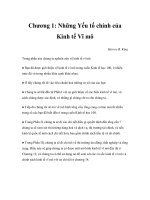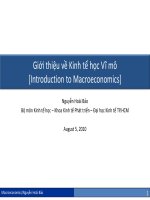Kinh tế vĩ mô Chap 1
Bạn đang xem bản rút gọn của tài liệu. Xem và tải ngay bản đầy đủ của tài liệu tại đây (650.65 KB, 22 trang )
MACROECOMICS I
Lecturer: Pham Xuan Truong
Foreign Trade University, Faculty of International Economics
Email:
Course content
Chapter 1 Introduction to macroeconomics
Chapter 2 Data of Macroeconomics
Chapter 3 Economic growth
Chapter 4 Saving, investment and financial system
Chapter 5 Unemployment
Chapter 6 Aggregate demand and Aggregate supply
Chapter 7 Aggregate expenditure and Fiscal Policy
Chapter 8 Money and Monetary Policy
Chapter 9 Inflation and Phillips curve
Chapter 10 Macroeconomics in open economy
Objectives
Acquire basic background of macroeconomics (GDP, CPI, AD-AS model,
unemployment, inflation, foreign exchange rate, fiscal policy, monetary
policy)
Use knowledge of the course to study other specialized economics (e.g.
development economics, public economics, environmental economics,
econometrics)
Apply academic background to practices (understand what financial and
economic news imply, explain what happens in the economy, estimate or
forecast economic policy)
Course implementation
Teaching
and learning methods: In class contact hours, there will be lectures,
discussions and assistance with student’s assignment works, reading and using books.
During the seminars the students will be expected to discuss the provided topics on the
problems of real economy
Assessment methods: There is a written assignment and final examination. It is worthy
30% and 60% respectively. Class participation is 10% .
Reading Textbooks
1 N.Gregory Mankiw,Principle of Macroeconomic, International Student Edition,Third
edition,Worth Pulisher,2003.
2 600 câu hỏi trắc nghiệm kinh tế học vĩ mô cơ bản, NXB Thông tin và truyền thông, 2012.
3 Frank and Bernanke, Principles of Macroeconomics Third edition, 2007.
4 Glenn Hubbard and Tony O’Brien, Macroeconomics, Second edition, 2008.
5 D.Begg,S Fisher,R.Dorchbusch,Economics,Third edition,McGraw-Hill Book Company,1991
Other references
1 The richest man in Babylon – Geogre Sclason
2 Naked Economics – Charles Wheelan
3 The Undercover Economist – Tim Harford
4 80/20 Principle – Richard Kock
5 Currency War – Song Hongbing
6 The exlusive quest for growth – William Easterly
7 Blue Ocean Strategy – Wchankim, Renee Mauborgne
8 Good luck – Alex Rovira, Fernando Trias de Bes
9 How to stop worrying and start living – Dale Carnegie
10 If you want it done right, You don’t have to do it yourself – Donna M.Genett
11 Who moved my cheese – Spencer Johnson
12 More sex is safer sex – Steve E. Landsburg
13 Three idiots (Indian version) film
Useful Websites
Domestic statistical websites
/> />%20k%C3%AA%20H%E1%BA%A3i%20quan
/> /> /> /> />
Useful Websites
Foreign statistical websites
/> /> /> /> /> /> /> /> /> /> /> /> />Economic information website
/> /> /> /> /> />
Chapter 1 Introduction to macroeconomics
Mentor Pham Xuan Truong
Content
I Basic concepts in Economics
1 Scarcity
2 Opportunity cost
3 Three fundamental questions in economic
II Overview of macroeconomics
1 What is macroeconomics
2 Objects and methods of research
3 Macroeconomic system
4 Objectives and policy tools of government to adjust macroeconomy
I Basic concept in Economics
1 Scarcity
- Definition: The situation in which unlimited wants exceed the
limited resources available to fulfill those wants
- The law of diminishing marginal returns/ product/ productivity
2 Opportunity cost
- Definition: The value of the next-best alternative that must be
forgone in oder to undertake the activity
- The law of increasing opportunity cost
I Basic concept in Economics
3 Economics
The study of the choices people make to attain their goals, given their scare
resources
Three fundamental questions in economic
Produce what
How produce
Produce for whom
Normative economics vs positive economics
Normative
economics
is
a
part
of economics that
expresses value or normative judgments about economic fairness, or what the outcome
of the economy or goals of public policy ought to be.
Positive economics is the branch of economics that concerns the description and
explanation of economic phenomena. It focuses on facts and cause-and-effect behavioral
relationships and includes the development and testing of economics theories
II Overview of macroeconomics
1 What is macroeconomics
Macroeconomics (from the Greek prefix makro- meaning "large" and economics) is a
branch of economics dealing with the performance, structure, behavior, and decisionmaking of an economy as a whole, rather than individual markets. This includes
national, regional, and global economies. With microeconomics, macroeconomics is one
of the two most general fields in economics.
Macroeconomists study aggregated indicators such as GDP, unemployment rates,
and price indices to understand how the whole economy functions. Macroeconomists
develop models that explain the relationship between such factors as national
income, output, consumption, unemployment,
inflation, savings, investment, international
trade and international
finance.
In
contrast, microeconomics is primarily focused on the actions of individual agents, such
as firms and consumers, and how their behavior determines prices and quantities in
specific markets.
II Overview of macroeconomics
1 What is macroeconomics
While macroeconomics is a broad field of study, there are two areas of
research that are emblematic of the discipline: the attempt to understand the
causes
and
consequences
of
short-run
fluctuations
in
national
income
(the business cycle), and the attempt to understand the determinants of longrun economic growth (increases in national income). Macroeconomic models and
their forecasts are used by governments to assist in the development and
evaluation of economic policy.
II Overview of macroeconomics
What is the object of macro and micro
1 Should FPT invest in new technology
2 Effect of increase of petroleum price on transportation
3 Whether Increase in input cost leads to increase in CPI
4 How Productivity affects GPD
II Overview of macroeconomics
2 Objects and methods of research
Objects
Macroeconomics focuses on 4 fundamental objects
Total output (aggregate output), economic growth, business cycle
Price level, inflation
Unemployment, social welfare
International trade, balance of payment, foreign exchange rate
Questions revolving 4 abovementioned objects are the issues researched by
macroeconomists
II Overview of macroeconomics
2 Objects and methods of research
Methods of reasearch
Economists use economic models to explore the choices people make and
the consequences of those choices. A model is any simplified
representation of reality that is used to better understand real-life
situations
In economics, a model is theoretically constructed to explain
economic processes by a set of variables and a set of logical and/or
quantitative relationships between them. The economic model often but
not always using mathematical techniques
II Overview of macroeconomics
2 Objects and methods of research
Methods of reasearch
Models
are important because their simplicity allows economists to focus on
the effects of only one change at a time. That is, they allow us to hold
everything else constant and study how one change affects the overall
economic outcome. So an important assumption when building economic
models is the other things equal assumption, which means that all other
relevant factors remain unchanged.
Collecting data
Observations
Hypothesis
Building model with
and check
assumptions
accuracy of the
model
II Overview of macroeconomics
3 Macroeconomic system
Macroeconomic system has three components: input, marcoeconomic activities
recording system (black box), output
+ input: exogenous and endogenous variables
+ black box: AD – AS model under affect of variables will produce macroeconomic
outcome
+ output: total output, inflation, unemployment, foreign exchange rate, interest rate
Inputs will go to black box, in which they interacts with market principles
and then outcomes of economy will be produced under aggregate numbers
For example: draught occurs then price level increases and output of the economy
decreases, which resulted from interaction of AD and AS
II Overview of macroeconomics
4 Objectives and policy tools of government to adjust macroeconomy
Objectives
Economic goals
Content
Economic efficiency
Making the most resources
Economic freedom
Freedom from government intervention in the production and distribution of goods and
services
Economic security and predictability
Assurance that goods and services will be available, payments will be made on time,
and a safety net will protect individuals in times of economic disaster
Economic equity
Fair distribution of wealth
Economic growth and innovation
Innovation leads to economic growth, and economic growth lead to higher standard of
living
Other goals
Environmental protection, human right protection
II Overview of macroeconomics
4 Objectives and policy tools of government to adjust macroeconomy
Policy
+ Fiscal policy: the use of government revenue collection (taxation) and expenditure
(spending) to influence the economy
+ Monetary policy: the process by which the monetary authority of a country controls
the supply of money, often targeting a rate of interest for the purpose of
promoting economic growth and stability
+ Income policy: economy-wide wage and price controls, most commonly instituted
by governments as a response to inflation, and usually below market level
+ Trade policy (commercial policy): a set of rules and regulations that are intended to
change international trade flows, particularly to restrict imports
Key concepts
Scarcity
Opportunity cost
Economics
Macroeconomics
Economic model
Normative economics, Positive economics
Macroeconomic system
Fiscal policy, Monetary policy, Income policy, Trade policy









